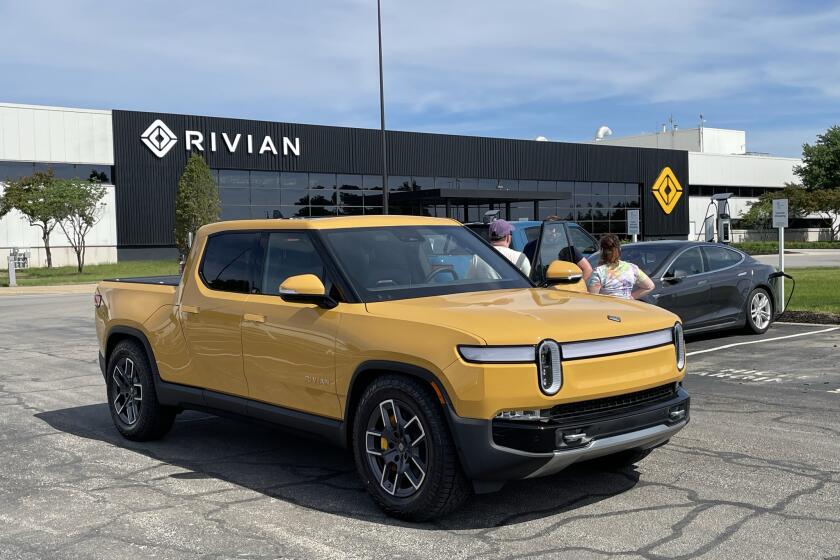Marketing : Cadillac Shifts Marketing Gears With Allante
Think of a fat, gas-guzzling car.
Cadillac.
Now, think of a sleek, ultra-luxury, two-seat convertible.
Cadillac?
On Oct. 2, General Motors premieres its $50,000 Allante--at no less than the Paris Auto Show. The folks at Cadillac Motor Car division hope to drive the Cadillac’s stodgy old image right down to the bottom of the Seine.
It won’t be easy. After all, over the years consumers have come to regard Cadillac as a car with all the sportiness of a Greyhound bus.
Cadillac is about to launch one of the auto industry’s most difficult image-modification ad campaigns. Industry executives and consultants say that seldom has an auto maker faced more formidable odds.
But after a steady decline in its share of the luxury car market, Cadillac has decided to travel a road that it has not traveled before: It is going after the Porsche and Jaguar set.
Analysts say that General Motors may have actually been forced into this position by Ford, which recently ran a Lincoln Town Car commercial that visibly demonstrated how closely GM cars--including Cadillacs--mirror each other.
Cadillac is not alone in going after the sporty, big-ticket buyer. Chrysler, for example, in a joint venture with Maserati, will introduce a $30,000 coupe next spring that should appeal to a similar market, said Arvid Jouppi, a Detroit auto industry consultant.
But Cadillac may be spinning its wheels. “Cadillac has one of the best luxury car positions on the face of the earth. They don’t need to change that,” said Jouppi.
By January, 1987, Cadillac expects to begin marketing its new image in series of regional and national television and print ads now being developed by D’Arcy Masius Benton & Bowles Inc. The ads will feature the slogan, “The New Spirit of Cadillac.”
Executives don’t expect to sell more than 6,000 of the Allantes. But it is an image boost--not big profits--that is their more immediate goal.
“You won’t see ads any more that picture Cadillacs parked in front of country clubs,” said John O. Grettenberger, general manager of General Motors’ Cadillac division. “The ads will feature the car and a description of what’s under the hood.”
One industry analyst says Cadillac appears to be on the right track--but the ride may be rough. “Remember,” said Philip Wade, strategic planner at the automotive consulting firm J. D. Power Associates, “there are lot more of the old Cadillacs around then new ones.”
Is Bank Ad Too Truthful?
Talk about truth in advertising: Mitsubishi Bank of California has just launched a radio and print campaign that actually brags about its “inconvenient” locations. The tag line reads, “With 24 inconvenient offices, MBC is the bank worth going out of your way for.”
Seeks Bigger Share of Pie
Denny’s Inc., the coffee shop chain that has spent three decades in search of an image, has been caught with its finger in the pie.
Specifically, apple, peach and coconut cream.
In a bid to enlarge its market share, the largest coffee shop chain on earth is turning its attention to a seemingly unlikely product: take-out pies. At $6.75 per pie, Denny’s executives want their slice of what some analysts say ranks among the fastest-growing--and most profitable--niches in the industry.
The biggest plum, however, isn’t the pie. Industry executives say that adding pies to the take-out menu can boost total food sales upwards of 20%. And pies can bolster image.
Well aware, however, that doubting consumers would hardly go gaga over a pie with the Denny’s label, executives have given a new look to a 15-year-old Denny’s concept--Mother Butler Pies.
Marie Callender it’s not. But with a big marketing blitz on tap, consumers will soon be familiar with Mother Butler.
Within the next year, Mother Butler pies will be sold at concession-like stands at all 130 Denny’s outlets in the Los Angeles area. And over the next five years, the privately held, La Mirada-based company will spend upwards of $40 million in its gradual conversion from a coffee shop to a pie palace, said Vern Curtis, chief executive.
“We’ve never had a signature item,” said Curtis, in a rare interview. “We wanted an item that people will think of immediately when they think of Denny’s.” Pies may very well become that item. The company plans to install Mother Butler Pie outlets in at least 70% of it 1,200 units nationwide, said Curtis.
To date, Denny’s has run a very low-key, mostly regional ad campaign on the product, as conceived by Foote, Cone & Belding. Television commercials--which have only appeared in the Milwaukee area--feature both older and younger couples enjoying heaping portions of the pie.
Industry analysts say Denny’s marketing move is not just pie in the sky.
“If Denny’s was smart,” said Bob Patterson, managing partner at Laventhol & Horwath’s Los Angeles office, “they’d eventually turn the whole operation into Mother Butler’s.”
Hefty Issue of TV Guide
Television ad revenue may be off this year, but don’t tell that to TV Guide. Stuffed with 140 advertising pages, its Sept. 13 fall-preview issue set records for ad pages and ad revenue ($1.35 million, up 12% from last year’s best). Circulation: 18.5 million TV junkies.
Toying With Vegetables
Odds are, no one on Madison Avenue has ever heard of Galloway Farms International.
After all, the Porterville, Calif.-based shipper and grower of vegetables doesn’t exactly run the sexiest business in town. Besides, a tomato is a tomato is a tomato.
Except when it’s Tomato Tron.
You know, a cousin to Kiwi Kicker. That’s Melon Blaster’s best buddy--a distant relation to Pea Splitter.
Sound familiar?
If you’ve purchased a toy for a child under 12 years old in the past few years, it should. The names have a striking similarity to newfangled children’s toys with labels such as Gobots and Transformers--esoteric vehicles that magically transform into hand-size robots.
Now, they’re lurking in the grocery store’s top profit center--the produce aisle.
Executives at the year-old, publicly held company recently held a corporate pow-wow over the pressing issue of the day: How to get kids to eat vegetables--particularly theirs.
“We sat around asking ourselves, what is it that General Mills does that allows it to sell 20 cents worth of corn in a box for $2.50,” said Dan Littleton, vice president.
The answer: child appeal.
Executives figured that if they gave their vegetables names reminiscent of popular children’s toys, sales would have to improve. After all, every ad executive worth his sugar knows that it’s the kids that pressure mom to buy certain cereals.
So why not vegetables? The first test was simple enough. Executives went to the produce aisles of local supermarkets in Porterville.
Kids who turned up their noses at lettuce were ecstatic when they were offered something called Ultra Lettuce--lettuce packaged with robot-like labels.
As a result, by mid-1987, the tiny company hopes to pump more than $250,000 into marketing an assortment of vegetables for children.
Some grocery industry executives are excited. “Imagine if we could extend into the children’s market,” said Terry Hasagawa, a senior buyer at Topco Associates, which buys vegetables from Galloway Farms.
“Why, we could even sell broccoli as a snack food.”
To be precise, that’s Broccoli Sauraus.



